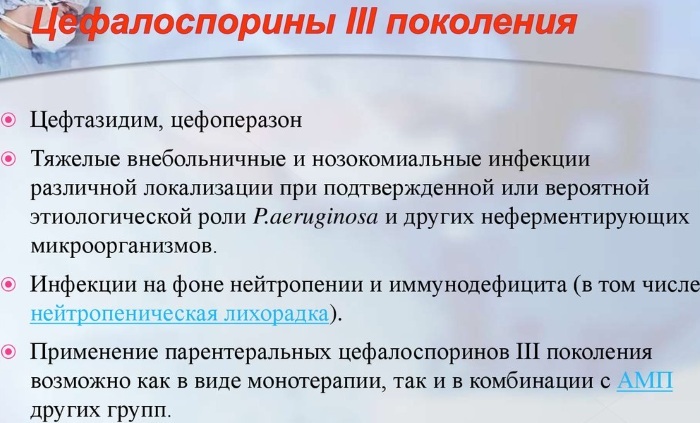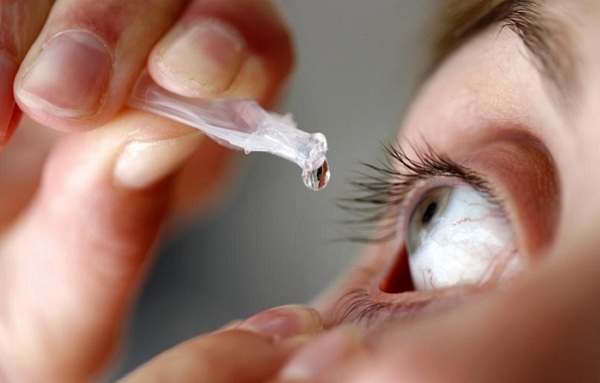Among antibacterial drugs of universal use Cefatoxim occupies a special place. This medicine is not available in pill form, but there are many analogues from the group of cephalosporins in oral form. Cefatoxime is usually prescribed for the complicated course of infectious diseases.
Record content:
- 1 Forms of release and composition of the drug
- 2 Pharmacological properties
- 3 Pharmacodynamics and pharmacokinetics
- 4 Indications for use
- 5 Contraindications
- 6 At what age can the drug be used?
-
7 Instructions for use, dosage
- 7.1 For children
- 7.2 For adults
- 8 Side effects
- 9 Overdose
- 10 special instructions
- 11 Drug interactions
- 12 Analogs
- 13 Terms, conditions of sale and storage
- 14 Price
- 15 Video about the drug
Forms of release and composition of the drug
Cefatoxime is the active substance of the same name in the composition of the drug, which belongs to the class of III generation cephalosporins. It is worth noting again that this product is produced only in the form of a dry lyophilisate for the preparation of an injection solution. Cefatoxime is represented by sodium salts in different dosages (500 mg and 1 g).
Manufacturers pack the powder for the preparation of infusion solution in 10 ml vials. 1 package can contain from 1 to 10 vials with cream-colored lyophilisate.
It should be noted that Cefatoxime is used for intramuscular and intravenous injections, droppers.
Pharmacological properties
Like most new generation antibiotics, Cefatoxime has a number of advantages and features of action. Unlike its predecessors, cephalosporin antibiotics, this drug practically does not have a toxic effect on the human body, which minimizes the risks of side effects.
Cefatoxime tablets (analogs of the cephalosporin group exist in other oral forms) are not sold, however, in inpatient conditions, the treatment of infectious and inflammatory diseases with injections is more effective.
This antibiotic has a detrimental effect on bacteria with any gram-belonging. Moreover, a significant therapeutic effect occurs after the first use of the medication.
Despite the high rates of bioavailability, Cefatoxime fights against pathogenic microorganisms with minimal stress on the digestive tract. The active substance destroys the structural membranes of the protein necessary to protect the cell membrane of the bacterium, thereby provoking its death. By itself, the substance cefatoxime has protection against enzymatic activity within the gastrointestinal tract.
This antibiotic shows good results in the treatment of diseases caused by:
- enterococci;
- streptococci;
- staphylococci;
- gonorrhea;
- clostridia;
- Proteus;
- pneumococci.
For maximum effectiveness of the agent, it is important to determine the type of pathogen and the degree of its susceptibility to the active ingredient before use.
Pharmacodynamics and pharmacokinetics
Cefatoxime is fully distributed through the bloodstream a few minutes after administration. After 5 minutes, the maximum concentration of the active component in the blood after taking a dose of 500 mg is about 38-39 μg / ml. As a result of the introduction of a larger dose, the indicator of the limiting concentration will increase in direct proportion.
After entering the bloodstream, the antibiotic goes through the stage of binding to plasma proteins, in which up to 50% of the active ingredient is involved.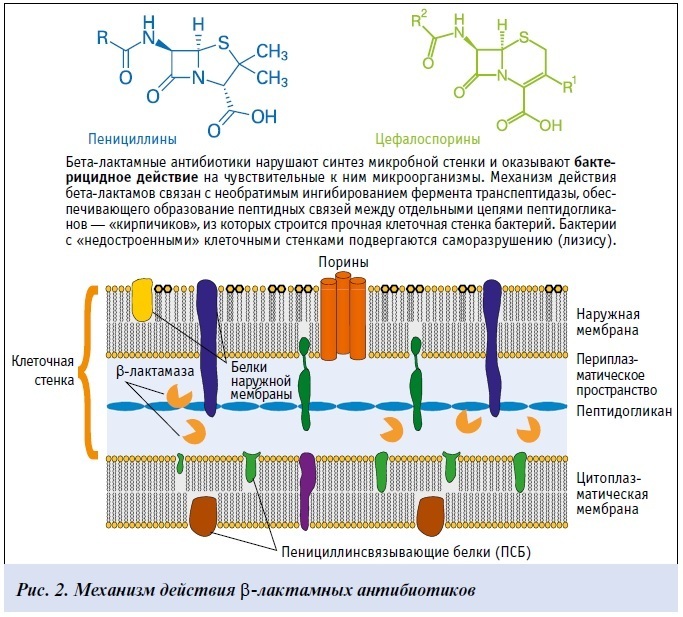
High bioavailability at the level of 90-95% assumes the penetration of cefatoxime into the structures of the tissues of the human body - from bones, skin, internal organs to biological fluids. In addition, the drug easily crosses the placenta and enters breast milk.
Repeated injections of Cefatoxim at a dosage of 1 g for 2 weeks every 6 hours do not contribute to the accumulation of the antibacterial substance in the body. The half-life of the drug is about 50-60 minutes after intravenous injection. If the antibiotic was injected intramuscularly, it will begin to leave the body later for 30-40 minutes.
Cefatoxime in tablets, analogues of which many patients are looking for in pharmacies, are not produced by either domestic or imported pharmaceutical companies. The drug goes through all stages of metabolism in the liver, but about 20-36% of the substance remains unchanged and is eliminated in the urine.
The pharmacokinetics of cephalosporin antibiotics can proceed according to a different scheme in elderly patients, as well as in children born prematurely. So, for example, in a child weighing less than 1.5 kg, the metabolism and excretion of this substance will require at least 3.5 hours.
Indications for use
The need to use this medication arises during the course of infectious and inflammatory diseases, accompanied by various complications. Cefatoxime injections are injected intravenously or intramuscularly if indicated, as prescribed by a doctor.
The basis for the use of this antibiotic is the following pathologies:
- meningitis and meningoencephalitis;
- acute respiratory diseases (bacterial and atypical pneumonia, bronchitis, lung abscess);
- dermatological diseases (furunculosis, carbuncle, streptoderma, pyoderma, erysipelas);
- burn injury of soft tissues, complicated by the addition of a bacterial infection;

- infections of the urinary tract and genital organs (pyelonephritis, cystitis, urethritis, cervicitis, balanoposthitis);
- sexually transmitted infections (syphilis, gonorrhea, chlamydia);
- tick-borne encephalitis;
- inflammation of the heart muscle;
- abdominal peritonitis.
This list of indications is not exhaustive. Cefatoxime is often prescribed to prevent postoperative complications. For the prevention of bacterial infection, antibiotic injections are prescribed for women after invasive abortion procedures.
Contraindications
Unlike previous generations of antibiotics, Cefatoxime has a relatively short list of limitations. The prohibitions indicated in the instructions on the use of this drug, as well as medicines of representatives of the cephalosporin group, can be conditionally divided into absolute and relative:
| Type of restrictions | Reason for contraindications | What complications can there be if the medication is used? |
| Absolute | hypersensitivity of the body to the active substance of the drug | symptoms of an allergic reaction in mild or severe form (up to death). |
| pregnancy | various disorders in the process of formation and development of organs and systems of the fetus. | |
| enterocolitis | intestinal bleeding | |
| acute renal failure | organ failure | |
| Relative | chronic liver failure | hepatic coma |
| chronic gastric or duodenal ulcer | the development of a relapse of the disease |
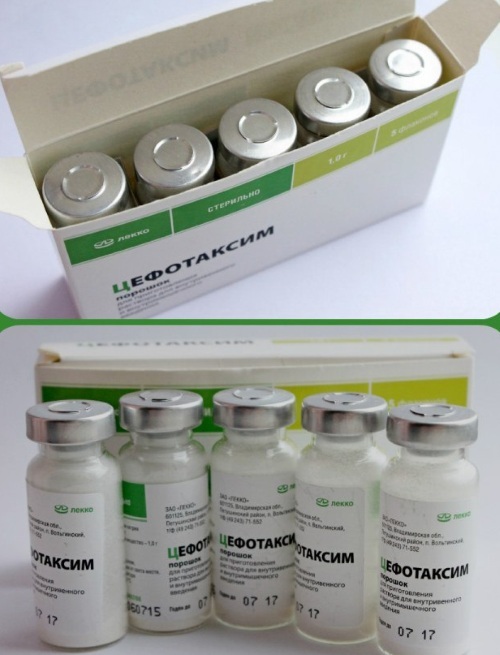
In the presence of relative contraindications, the use of Cefatoxim is possible after passing additional laboratory or instrumental studies.
If the diagnostic results allow the inclusion of a medication in the treatment program (for example, liver function tests are at an acceptable level), the doctor will prescribe this antibiotic to the patient, subject to constant monitoring of the condition sick.
Cefatoxime is not recommended for use in the treatment of patients who have already had an allergic reaction to antibacterial agents of the cephalosporin and penicillin series. In severe cases, this drug is prescribed to nursing women: such a decision is possible if the potential benefit to the mother outweighs the potential risk to the child.
At what age can the drug be used?
Cefatoxime, which does not exist in tablets, can be prescribed to children from the first days of life, unlike most analogues. Moreover, the restriction applies not only to the antibiotic itself, but also to the drug used as a solvent - Lidocaine.
For intramuscular injections, this agent is the most optimal and produces a long-lasting analgesic effect. However, it is impossible to inject Cefatoxime intramuscularly with lidocaine to children under 2.5 years of age.
Intravenous infusions have no age restrictions, but care should be taken in the treatment of newborns. With intolerance to Lidocaine, Novocaine is usually used, however, this anesthetic is an order of magnitude weaker than the previous one and can be prescribed to children over 12 years old.
Instructions for use, dosage
Depending on the type of infectious and inflammatory disease and its severity, 1 of 3 methods of drug administration are used:
-
Intravenous injections. To do this, dissolve the contents of one vial of Cefatoxime of the appropriate dosage in 4 ml of water for injection. Before collecting the ready-made solution into the syringe, it must be shaken thoroughly, having achieved complete dissolution of the small particles of the lyophilisate. The drug should be injected into a vein slowly, over 2-3 minutes.

- Droppers. In most cases, 1-2 g of Cefatoxim is used per 100 ml of normal saline (or glucose solution with a concentration of 5%). The duration of the manipulation should be at least 1 hour.
- Intramuscular injections. The solution must be prepared with an anesthetic in a ratio of 4 ml to 1 g of antibiotic.
For children
For genitourinary infections in a child aged 2.5 to 7 years, the recommended dose of the drug is 1000 mg. In the treatment of such diseases, it is important to observe the interval between injections. Normally, the break should be at least 10-12 hours.
In the treatment of pneumonia and respiratory diseases of moderate severity, the maximum daily amount of cefatoxime is 1-2 g. For children over 2.5 years old, any of the methods of drug administration is suitable, while it is important to remember: injections can be given to the child no more than 1 time in 12 hours.
For newborns and babies born prematurely, Cefatoxime is used intravenously, based on a special formula to calculate the dosage of 50 mg per 1 kg of body weight. For children over 2.5 years old, the dosage can be increased by 180 g per 1 kg of weight.
For diseases with a severe course (for example, meningitis), a single dosage can be increased to 2 grams, and the daily dosage - up to 12 g. Thus, in patients with an acute form of the disease, the drug must be administered at least 4-8 hours later.
For adults
Adolescents over 12 years old and adult patients should use the drug according to one of the proposed schemes:
- 1 g cefatoxime 3 times a day;
- 2 g of medicine 2 times a day.
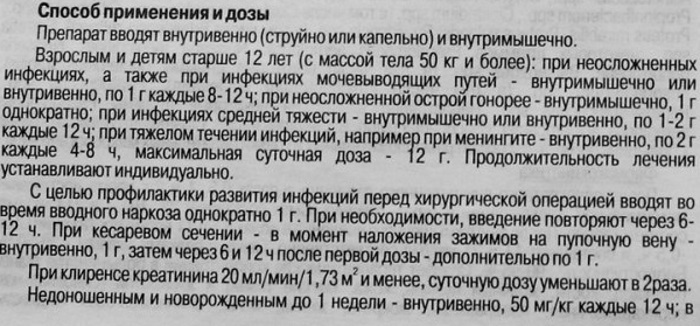
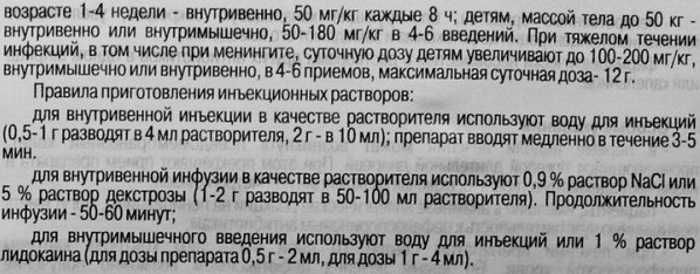
With a mild uncomplicated course of gonorrhea, 1 g of an antibiotic per day is enough with a single dose, and with atypical pneumonia or meningoencephalitis, the dose and frequency of administration are increased by 3-4 times.
As a prophylactic agent, Cefatoxime is used immediately before surgery, as well as 1 g of the drug 3 times a day on the first day after surgery. With prolonged operations, the antibiotic is re-administered after 6 hours. The dosage is determined by the doctor, based on the patient's body weight and the severity of the disease.
The duration of the course of treatment with Cefatoxime is also established by a specialist on an individual basis. The minimum course of taking the drug for diseases such as pneumonia and bronchitis is 7-10 days, and the maximum possible duration of antibiotic therapy is 14 days.
It is impossible to stop injections at the first improvements without completing the course of treatment to the end, since the pathogen will develop resistance to the drug, the course of the disease will resume and the condition will worsen.
Side effects
Cefatoxime (analogs in tablets will help you choose the attending physician) less often than other cephalosporins, it causes adverse reactions from different systems and organs.
In the instructions for use of the drug and patient reviews, the following side effects are mentioned:
- headache and dizziness;
- frequent urination;
- nausea;
- stool disorders;
- bloating and abdominal pain;
- development of intestinal dysbiosis.
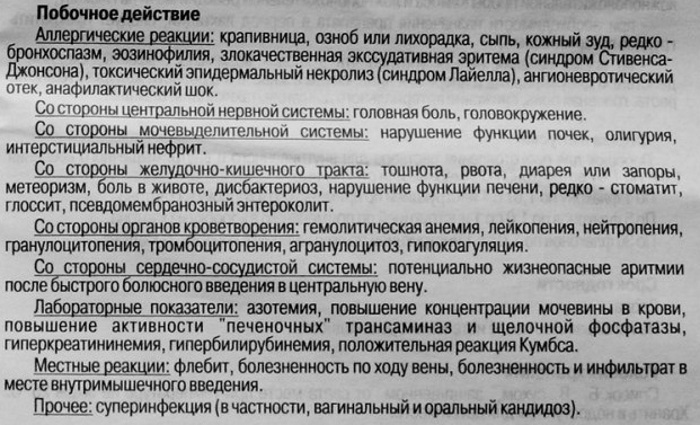
Antibiotics of the third generation have a minimal effect on the liver, however, in patients with chronic gland dysfunction, the level of bilirubin and the activity of hepatic transaminases sometimes increase. In rare cases, cefatoxime provokes the formation of aphthous lesions in the mouth and tongue.
With an allergy to an active substance, patients may experience skin rashes accompanied by itching, urticaria, chills. With intravenous administration, there is a risk of developing phlebitis, and with intramuscular administration - the appearance of pain at the injection site. In reviews of Cefatoxime, users also indicate cases of candidiasis.
Overdose
If the recommended dose is exceeded, the patient may experience disorders of neuromuscular excitability, expressed by tremors, convulsions, encephalopathy.
The latter symptom is more common in patients with chronic renal failure. In addition, when using an excessive amount of medication or not observing the time interval between injections, the above-described side effects may increase.
In case of an overdose, the patient is prescribed symptomatic treatment, since there is no specific antidote to cefatoxime. Therapy consists in refusal of further administration of the drug, immediate intake enterosorbents, antihistamines, and in severe cases - blood purification procedures (hemodialysis).
special instructions
Persons prone to an allergic reaction to penicillin drugs should consult a doctor and undergo an allergy test before taking Cefatoxime. In case of hypersensitivity to cephalosporins, the drug cannot be used.
In the first days of the course of injections, some patients experience symptoms of pseudomembranous colitis in the form of frequent loose stools, poorly amenable to relief with antidiarrheal agents. The drug should be discontinued and replaced with anti-inflammatory antimicrobial agents (for example, Metronidazole).
After 10 days of using Cefatoxime, the patient needs to undergo a general blood test to determine the level of erythrocytes and leukocytes in the blood.
With prolonged use of the antibiotic in high doses, leukopenia, thrombocytopenia, agranulocytosis develop, and the rate of blood coagulation decreases. In addition, the use of Cefatoxime may cause false positive urine sugar test results.
If it is necessary to use the drug for a nursing woman, lactation should be stopped or suspended for the period of treatment.
Patients with chronic pathologies of the digestive system, incl. with ulcerative colitis, the drug is administered starting with the minimum dose. In addition, enterocolitis can develop against the background of a course of injections, therefore, the appearance of symptoms indicating the development of colitis is the basis for refusing further injections of Cefatoxim.
With the correct dosage and adherence to the injection regimen, the antibiotic does not have a depressing effect on the central nervous system and does not affect attentiveness, the speed of psychomotor reactions.
Drug interactions
Cefatoxime (analogs in tablets, according to reviews, are less effective) inhibits the intestinal microflora and inhibits the synthesis of vitamin K.
Taking injections of Cefatoxim while taking medications that reduce platelet aggregation can be extremely dangerous, since there is a high likelihood of bleeding (especially in patients with gastric ulcer, 12-fold intestines).
The use of Cefatoxime in the treatment of infectious and inflammatory diseases in parallel with anticoagulants can lead to an increase in the action of the latter.

It is strictly forbidden to make injections with this antibiotic when used simultaneously with:
- aminoglycosides;
- diuretics;
- medicines that interfere with the absorption of calcium and suppress the tubular secretion in the kidneys (for example, with Probenicid).
The risk of developing internal bleeding increases in patients using Cefatoxime with drugs from the NSAID group. The drug does not interact with other antibiotics, therefore, it cannot be mixed with analogue solutions, medicines of cephalosporin, penicillin or other groups.
During the course of therapy with Cefatoxime, you should not drink alcohol. The combination with ethanol can lead to headaches, decreased blood pressure, shortness of breath, arrhythmias.
Analogs
Cefatoxime has many drugs with similar effects.
The most popular substitutes are:
- Claforan;
- Cefabol;
- Intrataxim;
- Cefantral.
They all contain the same active substance (cefatoxime) and belong to the group of III generation cephalosporins. These drugs are available in the form of a powder for the preparation of an injection solution.
The prices for analogs may differ several times, depending on the country of origin and dosage. Thus, Claforan is a French pharmaceutical product, Cefantral is of Indian origin, Intrataxime is imported from Spain, and Cefabol is a substitute from a domestic manufacturer.
Since Cefatoxime is not available in oral forms, it is worth paying attention to medications in the form of suspensions and tablets. When treating patients on an outpatient basis, the choice is often not made in favor of injections, especially when it comes to treating children.
Analogues of Cefatoxime are:
-
Panzef. The active ingredient is cefixime, which also belongs to the third generation cephalosporins. Approved for use in children after 6 months. Suspension costs about 450 rubles, tablets - 700 rubles.
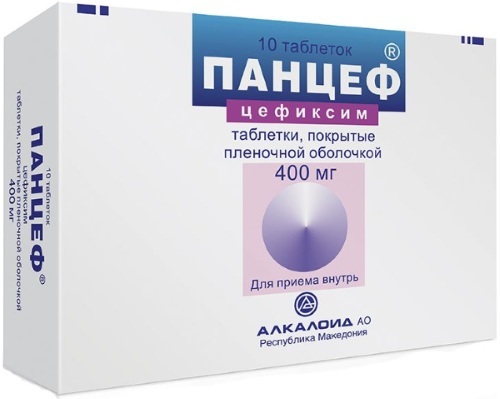
- Suprax. The drug is a complete analogue of Pansef, has the same indications for use as Cefatoxim.
- Zinnat. An antibiotic from a number of cephalosporins of the previous generation based on cefuroxime axetil, in the form of tablets and syrup. The price varies within 500 rubles. per packing.
Terms, conditions of sale and storage
The antibiotic Cefatoxime is sold in pharmacies only with a doctor's prescription. It is necessary to store vials with lyophilisate in a cool and dry place. Direct exposure to sunlight is detrimental to the drug, therefore, it is undesirable to remove the bottles from the cardboard packaging long before direct use.
The drug remains usable for 3 years from the date of release. An expired antibiotic cannot be used. The solution for injection must be prepared just before injection.
Price
In Russian pharmacies, the cost of Cefatoxime is 29 rubles on average. for 1 bottle. Both imported and domestic substitutes for this antibiotic have a higher price.
Most of the reviews on the discussion of the effectiveness of Cefatoxim and its analogs in tablets are positive. Users note the good tolerance of the drug and the possibility of using it in childhood with a minimum likelihood of developing side effects.
Video about the drug
Cefotoxime in ampoules:

